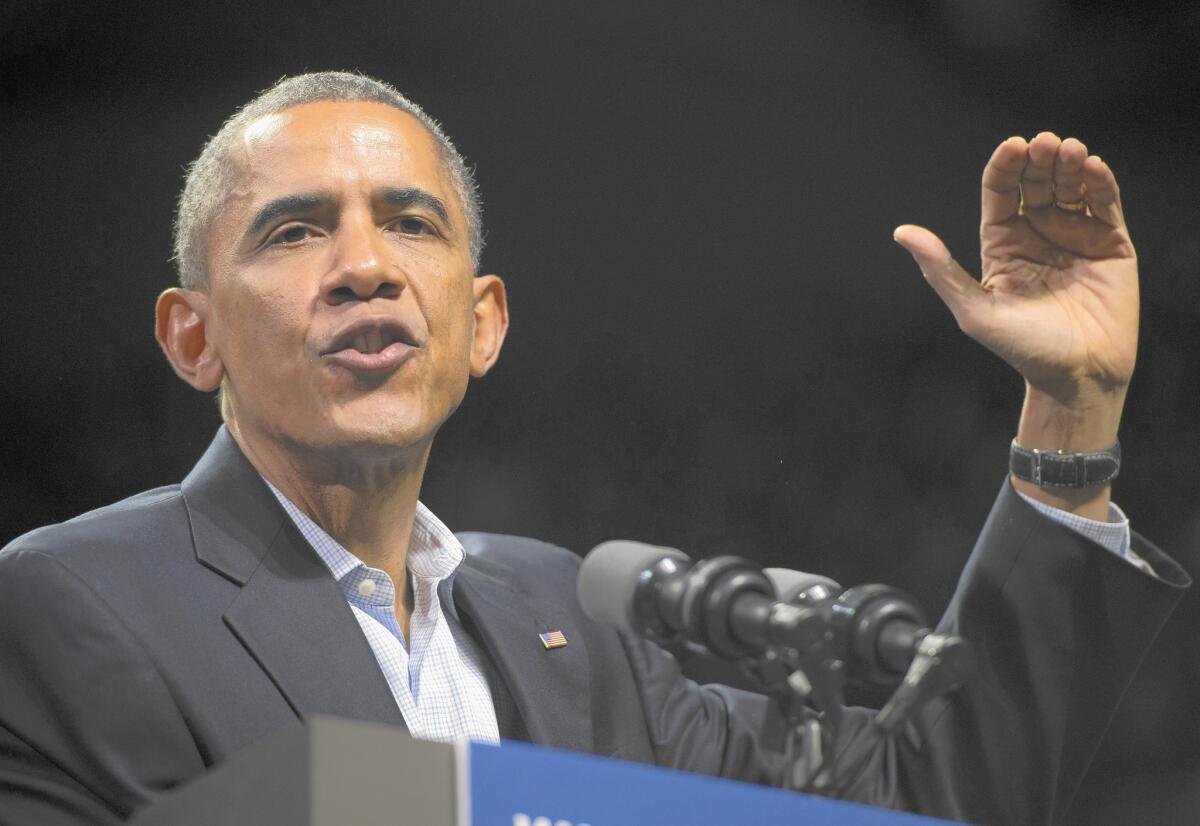Obama’s best chance to influence the judiciary may be passing

- Share via
Reporting from WASHINGTON — When 41-year-old gay rights lawyer Michelle Friedland was confirmed by the Senate in April to the federal bench in San Francisco, Democrats cheered that a liberal woman would become the youngest federal appeals court judge in the nation.
But when a restrictive Wisconsin voter-identification requirement was allowed to go into effect in September after the U.S. 7th Circuit Court of Appeals in Chicago deadlocked 5 to 5, Democrats winced. The law — later blocked by the Supreme Court — would presumably have been invalidated at the appellate court if President Obama had succeeded in filling a vacancy there now nearly five years old.
With Republicans striving to seize control of the Senate in Tuesday’s election, Obama’s first six years in office may mark the peak of his influence on the judiciary, including the appointment of two Supreme Court justices, Sonia Sotomayor and Elena Kagan.
Legal experts say it’s a record of unprecedented achievements in judicial diversity. Women make up 42% of his confirmed nominees, more than double the average of his five predecessors combined, while African Americans make up 18% and Latinos 6%. Eleven openly gay judges now serve where there was only one.
“It’s been quite an impressive record,” said Sheldon Goldman, a professor at the University of Massachusetts at Amherst who studies judicial nominations. “A large majority of his appointments — approximately 60% — have gone to nontraditional candidates, people who are not white males.”
Supporters are heartened that his most recent appointments, such as Friedland and Pamela Harris — confirmed to the appeals court in Richmond, Va. — have had more progressive views and records compared with his early choices.
And they are gratified that Democrats now hold a majority on nine of the 13 appeals courts, including the crucial District of Columbia Circuit Court of Appeals. Democrats had the majority on only three appeals courts when Obama came to office.
But there is also a lingering disappointment that it took the Obama administration several years to prioritize judicial nominations, making it harder to catch up with vacancies.
Despite a flurry of nominations over the last year — which came after Senate rules were changed to make confirmations easier — there are still 63 judicial vacancies, 10 more than when Obama took office. He nominated fewer than half as many judges in his first year as President George W. Bush did.
“It was a slow start, but once they got rolling and put some muscle behind the nominees, they started to get some people through,” said Caroline Fredrickson, president of the American Constitution Society, a liberal legal group. “Originally the priority was on getting the Affordable Care Act through and the nominations process took a back seat.”
Some suggested that the goal of diversity complicated the process early on.
“There is no question that diversity has been a high priority for the administration and that’s reflected in the diversity score card, but it also accounts for a lot of the slowness in the nominations, especially in the early years,” said Ed Whelan, a conservative legal analyst. Whelan said the difficulty in coming up with the right balance of minority candidates made for slow going on nominations.
A White House official who would not be identified speaking about personnel matters said that in its first two years the administration was occupied by the selection and confirmation of Sotomayor and Kagan.
Some liberals think Obama’s unwillingness to spend political capital on confirming judges in his early years led to the appointment of more moderates, particularly when compared with Bush’s record. Karl Rove, Bush’s deputy chief of staff, made the selection of judicial conservatives a priority from the start of Bush’s presidency.
Until Kathryn Ruemmler became White House counsel in 2011, no top official in the Obama White House made judges a priority, liberals complain.
But Obama also faced implacable opposition from Republicans, who frequently used filibusters to block even his uncontroversial nominees. Adding to the difficulties was Senate Judiciary Committee Chairman Patrick J. Leahy’s strict interpretation of arcane committee traditions, which effectively granted veto power over nominations to home-state senators.
Last November, Senate Democrats eliminated the filibuster rule for most judicial nominees, allowing them to approve dozens of nominations by a simple majority vote and freeing Obama to look for more liberal nominees.
But because Leahy, a fellow Democrat, allowed any home-state senator to block a nominee from committee consideration, the logjam was broken only in the 19 states with two Democratic senators. Often Obama has declined to nominate judges in states with Republican senators, leaving seven crucial appeals court seats, including the one on the 7th Circuit in Chicago, without a nominee.
“It is the responsibility on the part of the president to at least get a nominee in front of the Senate,” said former Sen. Richard G. Lugar (R-Ind.), a critic of delays by both parties in filling judicial vacancies. “It seems to me the White House has an obligation to put greater pressure on the senators to move nominations forward.”
Democrats will attempt to push 25 more Obama nominees through the lame-duck Senate session that will start Nov. 12, but 27 more judges have announced they are leaving. That means total vacancies at the start of the year are likely to rise again slightly — to 65.
More to Read
Get the L.A. Times Politics newsletter
Deeply reported insights into legislation, politics and policy from Sacramento, Washington and beyond. In your inbox twice per week.
You may occasionally receive promotional content from the Los Angeles Times.











